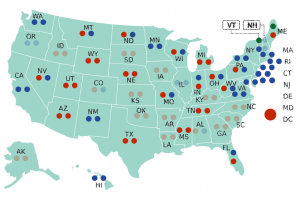LatinaLista — The Pew Hispanic Center released a report today analyzing the Latino turnout in the 2010 midterm elections. According to the study, The Latino Electorate in 2010: More Voters, More Non-Voters, there are some marked distinctions among Latino subgroups regarding civic participation.
However, the one area of discussion that has always been considered the elephant in the room and finally gets addressed in statistical detail in this report is the reality that 22.4 percent of the Latino population is not eligible to vote due to citizenship status. In fact, that percentage attributes to the fact that only 43 percent of the national Latino population is eligible to go behind the curtain versus “(77.7%) of whites, two-thirds of blacks (67.2%) and more than half of Asians (52.8%) who are eligible to vote.”
Though it’s been known that non-citizens impact Latino voter turnout, they can’t entirely be blamed. After all, if given the opportunity to become citizens they would most probably register to vote and exercise their civic duty. Unlike those young Latinos who are eligible but choose not to bother with the electoral process.
In 2010, 31.3% of Latino eligible voters were ages 18 to 29, while 19.2% of white, 25.6% of black and 20.7% of Asian eligible voters were under 30. Among young Latino eligible voters, just 17.6% voted. In contrast, among Latino eligible voters ages 30 and older, the voter turnout rate was higher–37.4%.
The gap in voter participation between Latinos and others is also partly due to fast growth in the number of Latinos who do not vote, but are eligible to do so. Between 2006 and 2010 the number of Latino voters increased by 18.8%, but the number of Latino non-voters increased more rapidly, by 25.0%.
The study further breaks down voting behaviors finding that Latino college graduates had the higher voter turnout rates while young Latinos, ages 18-29, had the lowest. Among subgroups of Latinos, those of Cuban ancestry turned out in higher numbers to vote while Latinos of Mexican descent turned out in lower numbers at 29 percent.
Yet, the real eye-opener is that the study’s authors found that 37 percent of naturalized foreign-born Latinos voted compared to 29 percent of native born Latinos.
This study underscores the fact that the Latino community is not homogenous. Civic participation means more to a few segments than all the rest. While political strategists would use this study to figure out what segments of the population to target their voter registration drives and “Get out the Vote” campaigns, this study needs to be studied in detail by Latino organizations who anticipate not only a strong Latino voting bloc in the years to come but a strong community overall.
This study provides a snapshot of a community that is civically disenfranchised by choice because they don’t see what participating in the voting process does for them.
There were high hopes by this very same group of young people after the 2008 election, even though some weren’t eligible to vote. Yet, they were energized to get people to vote for Obama. When Obama’s administration failed to come through on the promise of passing DREAM Act and immigration reform to legalize the status of these young people, their friends or family members, it sucked the civic enthusiasm right out of them.
Knowing specifically that it’s exactly this age group — 18-29 — who are sitting out politics should be a wake-up call to Democrats if they want the Latino vote again and an alarm bell to Republicans that if they compromise just a bit on DREAM and immigration reform, their chances among Latino voters could vastly improve.
It’s a segment of the Latino population striving for respect, to be heard and shown that their voices do matter.





